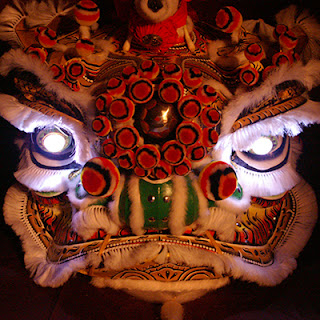As we begin 2013 in the West, the Year of the Water Snake (4711) is rapidly approaching. Along with that will be lots of lion dance performances, including many at night or in other low-light conditions. So how do you make sure your lions are ready? By installing lights of course!
"Bright eyes" is a common expression to describe someone full of life and that's exactly the image we want lions to portray. In Chinese one term for the Southern Lion is "Sing Si" or "Awakened Lion" so anything that helps the lion look awake and alert is a good thing. Lights in the eyes really bring attention to the lions, especially in a darkened room or at an evening performance outdoors.
Here's a shot of the original setup to light the lion's eyes. You can see it was fitted with standard flashlight incandescant bulbs which would be hooked up to a switch and several batteries.
At the time the lion was originally built this was a great solution and worked well for many years. However there were several drawbacks to using it. The main one is that incandescant bulbs tend to use a lot of power so we would drain several sets of batteries over the course of our New Years performances. I remember our group coordinators getting after us to, "Remember to turn off the lights!" after every performance. You could always add more batteries or use a larger size (we had lions that used everything from AA to a couple of D cell batteries) but this would add significant weight to the lions.
Since installing them and showing them off I've actually gotten requests to build and sell light sets to other groups and have sold a dozen or so. I never thought there was much of a market for things like this, but what a nice confirmation that the work I put into researching, designing and building them is recognized and appreciated by others and also that my work is going on to help other groups as they help spread the art.
I'm watching you!
Here's the final result. What do you think? Feel free to comment below, thanks!



No comments:
Post a Comment